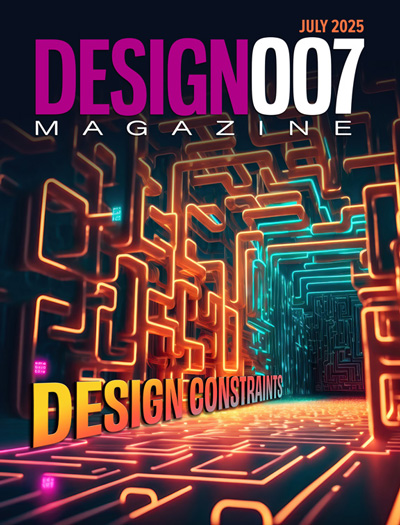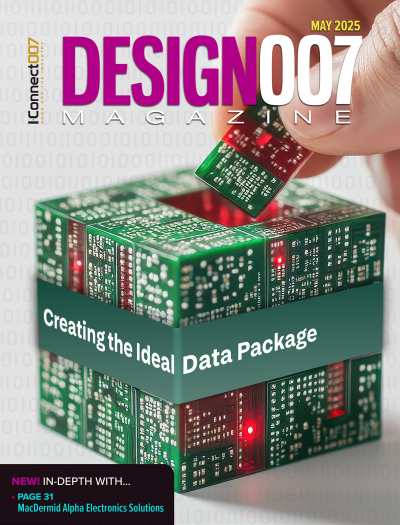-

- News
- Books
Featured Books
- design007 Magazine
Latest Issues
Current Issue
Showing Some Constraint
A strong design constraint strategy carefully balances a wide range of electrical and manufacturing trade-offs. This month, we explore the key requirements, common challenges, and best practices behind building an effective constraint strategy.

All About That Route
Most designers favor manual routing, but today's interactive autorouters may be changing designers' minds by allowing users more direct control. In this issue, our expert contributors discuss a variety of manual and autorouting strategies.

Creating the Ideal Data Package
Why is it so difficult to create the ideal data package? Many of these simple errors can be alleviated by paying attention to detail—and knowing what issues to look out for. So, this month, our experts weigh in on the best practices for creating the ideal design data package for your design.
- Articles
- Columns
- Links
- Media kit
||| MENU - design007 Magazine
EDA Tools and RF Design Techniques
April 14, 2025 | Andy Shaughnessy, Design007 MagazineEstimated reading time: 2 minutes
High-speed PCB design is complex enough, but RF design can be a whole new ball game. RF designers have to contend with tuning and other ideas that traditional PCB designers don’t have to worry about, as well as crosstalk, parasitic capacitance, and material limitations.
Most PCB design tool companies now offer RF design options, so designers no longer have to use pureplay RF design tools for anything but the most cutting-edge designs. Cadence Design Systems expanded its RF EDA offerings by acquiring the RF software company AWR a few years ago. We asked David Vye, product management director at Cadence, to share his thoughts on EDA software, RF design, and what new RF designers and engineers need to understand.
Andy Shaughnessy: David, what are the most common challenges facing PCB designers and EEs in the RF space today? So many electronic devices today have GPS, Bluetooth, and Wi-Fi all together on the same PCB, and you wonder how they can all “play nice” with each other.
David Vye: For some time, many of the challenges that come with implementing RF technology in PCB systems relate to trends that have been evolving with each new communication standard. These system requirements (think 4G, 5G, and now 6G) include greater integration of functionality, reduction in footprint and power consumption, the move to higher frequencies and/or bandwidths, as well as the adoption of beamforming antennas to extend the system range. For the RF engineer, this leads to multiple technical considerations such as maintaining signal integrity, managing multiple high-frequency signals, ensuring proper impedance matching, and minimizing noise and interference, all while balancing performance, manufacturability, and space constraints. You’ve mentioned several different wireless standards; many of them exist together in a single device, serving a wide range of applications and consumer preferences for speed, quality of service, battery life, and the lowest possible cost.
Fitting multiple radio front ends into the smallest possible form factor requires smart layout strategies, proper shielding to prevent high-frequency signals from coupling to sensitive traces, a solid understanding of performance vs. cost trade-offs pertaining to component selection, and an awareness of non-RF issues such as thermal and stress-related effects that can impact the reliability of a PCB-based system. These considerations can be addressed with design and simulation software that provides insight into optimal system architecture and component selection via budget analysis, PCB passive component design capabilities through RF circuit simulation, and design verification through electromagnetic and thermal analyses. To reduce design turnaround times, these capabilities offer the greatest benefit when they are tied into a layout platform that offers a constraint-driven PCB design approach, which emphasizes defining design intent through rules for electrical, physical, and manufacturing aspects, ensuring first-pass success and streamlining the design process.
To read this entire conversation, which appeared in the April 2025 issue of Design007 Magazine, click here.
Testimonial
"In a year when every marketing dollar mattered, I chose to keep I-Connect007 in our 2025 plan. Their commitment to high-quality, insightful content aligns with Koh Young’s values and helps readers navigate a changing industry. "
Brent Fischthal - Koh YoungSuggested Items
Ansys 2025 R2 Enables Next-Level Productivity by Leveraging AI, Smart Automation, and Broader On-Demand Capabilities
07/30/2025 | PRNewswireAnsys, now part of Synopsys, announced 2025 R2, featuring new AI-powered capabilities across the portfolio that accelerate simulation and expand accessibility.
Target Condition: The 5 Ws of PCB Design Constraints
07/29/2025 | Kelly Dack -- Column: Target ConditionHave you ever sat down to define PCB design constraints and found yourself staring at a settings window with more checkboxes than a tax form? You’re not alone. For many designers—especially those newer to the layout world—the task of setting up design constraints can feel like trying to write a novel in a language you just started learning.
Zuken to Showcase Defence & Security-Focused Electronic Systems Design Solutions at DSEI 2025
07/24/2025 | ZukenZuken, a global leader in electronic and electrical design automation, will showcase its latest innovations for defence and security systems at DSEI 2025, taking place at ExCeL London from 9–12 September 2025.
Creating a Design Constraint Strategy
07/24/2025 | I-Connect007 Editorial TeamMost designers learn how to set their design constraints through trial and error. EDA vendors’ guidelines explain how to use their particular tools’ constraints, and IPC standards offer a roadmap, but PCB designers usually develop their own unique styles for setting constraints. Is there a set of best practices for setting constraints? That’s what I asked Global Electronics Association design instructor Kris Moyer, who covers design constraints in his classes.
Elementary Mr. Watson: Closing the Gap Between Design and Manufacturing
07/23/2025 | John Watson -- Column: Elementary, Mr. WatsonModern PCB designers are not merely engineers or technicians. I believe that PCB design, at its core, is an art form, and modern PCB designers should be considered artists. Beyond the technical calculations and engineering rules lies a creative process that involves vision, balance, and a passion for what we do. Like any artist who works with brush and canvas or chisel and stone, a PCB designer shapes invisible pathways that bring ideas to life. Each trace, layer, and component placement reflects thoughtful decisions that blend form, fit, and function.


